| Columns Retired Columns & Blogs |
PSB Stratus Gold loudspeaker 1997 Measurements
Sidebar 2: 1997 Measurements
The Stratus Gold i was relatively insensitive, 2.83V raising a calculated 84dB on the midrange axis at 1m. Its impedance curve (fig.1) also suggested that it needs to be partnered by an amplifier capable of a healthy current delivery. Not only does the impedance drop to a low 2.72 ohms at 97Hz, but the phase angle is quite severe through the midbass region. This curve, however, does imply excellent low-bass extension, the "saddle" in the curve around 25Hz indicating the tuning of the big port.
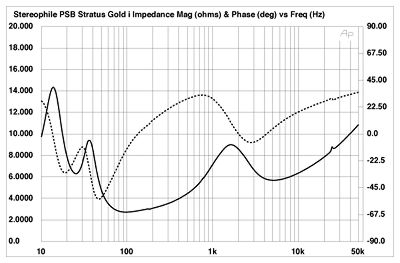
Fig.1 PSB Stratus Gold i, electrical impedance (solid) and phase (dashed) (2 ohms/vertical div.).
Note the slight wrinkles in the impedance curves at 24.6kHz and just below 190Hz. The former is due to the metal-dome tweeter's primary resonance and is innocuous; the second is due to the presence of some kind of cabinet resonance. Fig.2 shows a cumulative spectral-decay or waterfall plot calculated from the output of a piezoelectric plastic-tape accelerometer fastened to the center of the enclosure sidewall about 12" from the floor. Two resonant modes can be seen, at 188Hz and 325Hz, but these are both well down in level. The Stratus Gold's cabinet, with its large panels, is obviously well braced. I didn't notice any corresponding lower-midrange coloration in my auditioning.
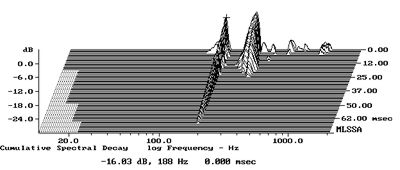
Fig.2 PSB Stratus Gold i, cumulative spectral-decay plot of accelerometer output fastened to cabinet back panel above terminals. (MLS driving voltage to speaker, 7.55V; measurement bandwidth, 2kHz.)
Fig.3 shows the individual responses of the woofer and port, together with that of the midrange and tweeter. The woofer takes over below 250Hz or so, with a smooth, third-order rollout above that frequency. The port seems somewhat overdamped, but is tuned to a low 25Hz. The Stratus Gold i's overall response, averaged across a 30 degrees lateral window on the midrange axis (39" from the floor), can be seen in fig.4. Other than a very slight presence-region depression between 2kHz and 4kHz and a narrow ripple an octave lower, the response is astonishingly flat. There is also a small rising trend on-axis between the presence and high-treble regions, which might correlate with my feeling that the Gold i sounded slightly "cold." In the bass, the speaker is 6dB down at a low 30Hz.

Fig.3 PSB Stratus Gold i, acoustic crossover on midrange axis at 50", corrected for microphone response, with the nearfield midrange, woofer, and port responses plotted below 600Hz, 300Hz, and 600Hz, respectively.
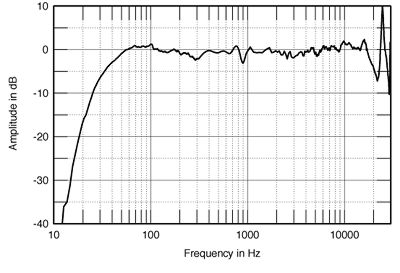
Fig.4 PSB Stratus Gold i, anechoic response on midrange axis at 50", averaged across 30 degrees horizontal window and corrected for microphone response, with the complex sum of midrange, woofer, and port responses plotted below 300Hz.
I remarked in my auditioning notes on the Gold's well-defined stereo imaging. I wasn't surprised, therefore, to see that the speaker's lateral dispersion (fig.5) was well-controlled and even. However, the top octave above 15kHz rolls off very rapidly to the speaker's sides, and there is a slight off-axis flare in the mid-treble, this coincident with the region where the on-axis output has a slight depression. Vertically (fig.6), the speaker's balance hardly changes within a 20 degrees window centered on the midrange axis, but above that, a suckout appears in the upper crossover region.
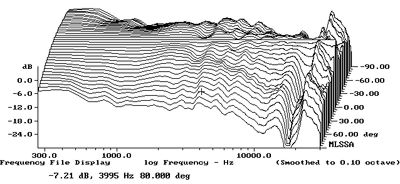
Fig.5 PSB Stratus Gold i, horizontal response family at 50", normalized to response on midrange axis, from back to front: differences in response 90 degrees-5 degrees off-axis; reference response; differences in response 5 degrees-90 degrees off-axis.

Fig.6 PSB Stratus Gold i, vertical response family at 50", normalized to response on midrange axis, from back to front: differences in response 15 degrees-5 degrees above axis; reference response; differences in response 5 degrees-10 degrees below axis.
In my listening room, the spatially averaged response (fig.7) indicates that the entire woofer region was balanced about 4dB too "hot"—no wonder I was so impressed by the speaker's bass performance. But this was subjectively acceptable because of the well-damped nature of the Gold i's low frequencies. Above the slight, floor-reflection-related dip in the lower mids, the Stratus Gold's in-room response is quite flat. But within the ±2dB limits that cover the almost two decades from 200Hz to 16kHz, there is a slight energy excess in the low treble. This, too, might have contributed to my feeling that the sound was slightly "cold."

Fig.7 PSB Stratus Gold i, spatially averaged, 1/3-octave response in JA's listening room.
In the time domain, the PSB's step response on the midrange axis (fig.8) reveals the tweeter and midrange to be connected with positive acoustic polarity, the woofer with negative. The speaker is obviously not time-coherent on this axis, but as the return to the time axis of each drive-unit neatly blends into the wave launch of the next, this implies good integration and a well-balanced frequency response...as we saw above. Finally, the Stratus Gold i's acoustic waterfall plot (fig.9) is clean throughout the upper midrange and treble.

Fig.8 PSB Stratus Gold i, step response on midrange axis at 50" (5ms time window, 30kHz bandwidth).
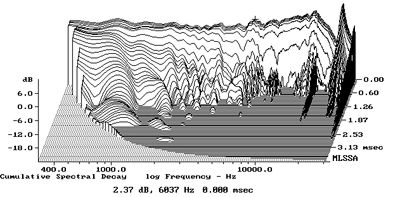
Fig.9 PSB Stratus Gold i, cumulative spectral-decay plot at 50" (0.15ms risetime).
Overall, this is very impressive measured performance, and correlates nicely with my positive auditioning impressions.—John Atkinson
- Log in or register to post comments




































